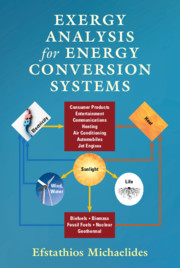Book contents
- Exergy Analysis for Energy Conversion Systems
- Exergy Analysis for Energy Conversion Systems
- Copyright page
- Dedication
- Contents
- About the Author
- Preface
- Symbols
- Abbreviations
- 1 Introduction
- 2 Exergy
- 3 Energy Conversion Systems and Processes
- 4 Exergy Consumption and Conservation
- 5 Exergy in Biological Systems
- 6 Ecosystems, the Environment, and Sustainability
- 7 Optimization and Exergoeconomics
- Index
- References
6 - Ecosystems, the Environment, and Sustainability
Published online by Cambridge University Press: 19 March 2021
- Exergy Analysis for Energy Conversion Systems
- Exergy Analysis for Energy Conversion Systems
- Copyright page
- Dedication
- Contents
- About the Author
- Preface
- Symbols
- Abbreviations
- 1 Introduction
- 2 Exergy
- 3 Energy Conversion Systems and Processes
- 4 Exergy Consumption and Conservation
- 5 Exergy in Biological Systems
- 6 Ecosystems, the Environment, and Sustainability
- 7 Optimization and Exergoeconomics
- Index
- References
Summary
Energy usage by an exponentially increasing human population has created environmental problems that are stressing several ecosystems on earth. The concept of eco-exergy (which is not equivalent to mechanical work) has been used to explain the relationship between energy use and the formation of complex organisms in ecosystems. The harmonious co-existence in ecosystems has inspired the notion of industrial ecology as a paradigm for the improvement of exergetic efficiencies and complete utilization of resources. The exergy-environment nexus and the implications of exergy analyses on sustainable development are critically examined in this chapter. Environmental exergonomics, exergoenvironmental analysis that includes eco-indicators, life-cycle exergy analysis, and sustainability indices are theoretical tools that use exergy and other thermodynamic variables to define the state of the environment and to recommend industrial practices that would alleviate the detrimental effects of energy use and would promote global environmental stewardship and sustainability.
Keywords
- Type
- Chapter
- Information
- Exergy Analysis for Energy Conversion Systems , pp. 251 - 272Publisher: Cambridge University PressPrint publication year: 2021



